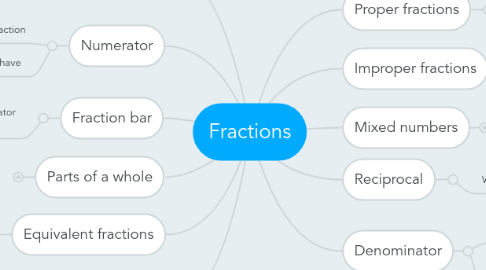Fractions
作者:Elena Collett

1. Numerator
1.1. The top number of a fraction
1.2. Shows how many parts we have
2. Fraction bar
2.1. The line that separates the numerator and the denominator
3. Parts of a whole
3.1. Recognizing equal parts of a whole (e.g. pizza cut in 8 pieces, there are 8 pieces)
4. Equivalent fractions
4.1. Fractions that represent the same number (e.g. 1/4 and 2/8)
5. Why do we need fractions?
5.1. Measuring: cooking, baking, math,etc.
5.2. A way of showing portions less than 1
6. Size of a fraction
6.1. Comparing fractions and understanding which one is bigger and which one is smaller.
7. Denominator
7.1. The bottom number of a fraction
7.2. Shows how many equal parts the item is divided into
8. Proper fractions
8.1. When numerator is smaller than denominator
9. Improper fractions
9.1. When the numerator is greater than the denominator
10. Mixed numbers
10.1. When an expression consists of a whole number and a proper fraction
11. Reciprocal
11.1. When the product of a fraction equals 1 (e.g. 3/3)


